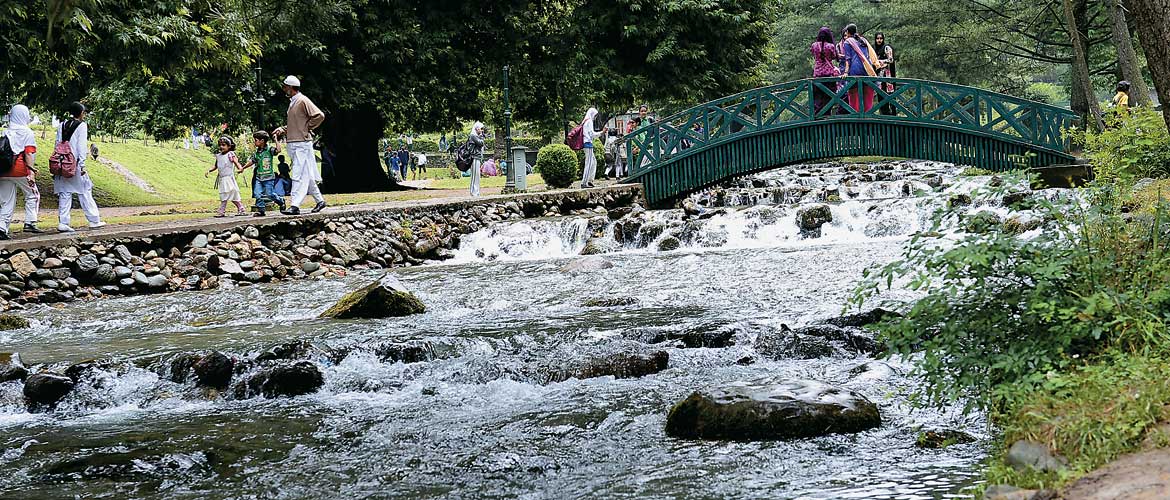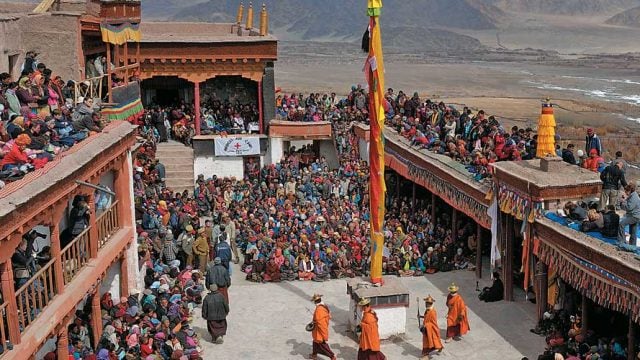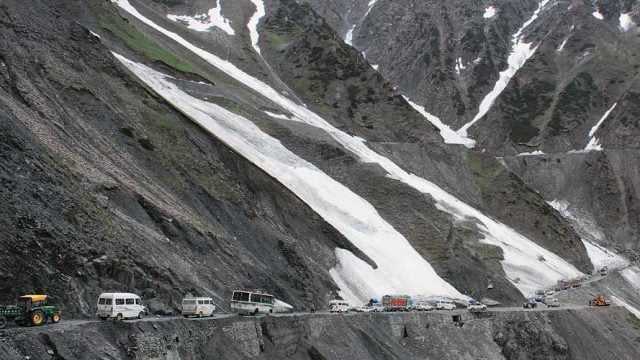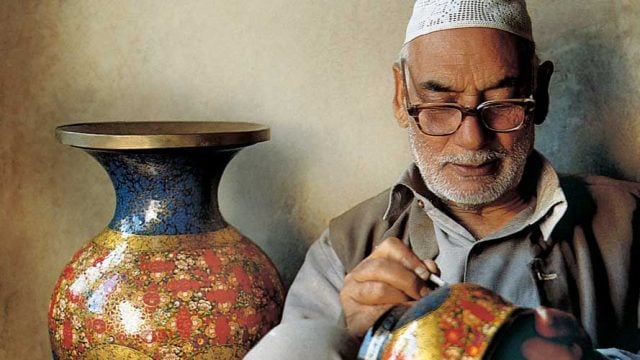A hoopoe with its beautiful crown, a false set of eyes and a mouth painted

Kokernag is named for a gushing spring which emerges from below a densely wooded hill. Strictly speaking, it’s a set of seven springs and hence the name: ‘koker’ means fowl and ‘nag’ spring; the many adjacent springs remind you of the claws of a fowl. The spring has been famous over centuries for its beauty and for the curative properties of it water. Famous enough to find mention in the Ain-i-Akbari. However, for some mystifying reason which will doubtless leave historians permanently puzzled, the Mughals eschewed their regular practice and did not make a garden here.
Only in the 1970s was this anomaly rectified and a botanical garden built at Kokernag as an ode to the divine waters. Not being a ‘Mughal Garden’ means you don’t find any jugalbandi of stone and water here, and no baradaris either; just the water in its green, very green surroundings. The garden is a popular picnic spot for locals, and a lovely holiday spot for visitors.

THINGS TO SEE AND DO
The spring and the botanical garden are the whole point of Kokernag. A small habitation lives around it on the road from Achabal to Daksum. Just outside the garden is a collection of dhabas and small shops; next door is a trout farm.
Botanical Garden
The 15-acre Botanical Garden runs along a hill, pines rushing down the hillside, huge and magnificent chinars rising high, and billowing chestnut trees spread below. The water flows amidst a Kashmiri carpet of grass over pebbles through a channel, under a network of wooden bridges. The garden has roses and manicured shrubs, but it’s the trees that grab the attention — and don’t let go. At one end of the garden, the spring emerges from the hillside so abundantly that it feels as if an irrepressible underground stream has found a way out. People lounge and children play all day long, leaving a dense darkness behind at night.

Trout Farm
Next to the Botanical Garden is a Trout Farm run by the J&K Fisheries Department, set up in 1960s. The farm, the biggest in the state, produces about 25 lakh trout in a year. It is worth a visit to see the fish in various stages of growth and to learn how they are farmed in channels that are called ‘raceways’. You can also buy rainbow trout here.
WHERE TO STAY AND EAT
This subz-bagh is a place worth spending a night in, especially for the dark silence that engulfs it and for the blessings of the morning. The sound of the water becomes part of that silence in Kokernag, as does the occasional call by the ducks. You wake up to the chirping of the resident birds. Out in the garden, in April-May, you find the chestnut has dropped a white carpet of florets at your feet.
Trout fish flourishing in Kashmir’s wild streams
JKTDC (Mobile: 09419450902; Tariff: ₹650-4,000) has a few staying options here, all within the garden precincts. The four rooms (Tariff: ₹1,000 and ₹1,300) in a wooden bungalow under a chinar tree are the most atmospheric of the lot. The rooms are spacious with a sit-out from where you can gaze at the greenery around you. Two 2-room huts (Tariff: ₹4,000) near the garden periphery give you a more secluded stay, away from the picnicking business of the botanical garden. The budget Alpine Hotel (Tariff: ₹650) is next to the entrance.

The JKTDC kitchen feeds you basic north Indian vegetarian and non-veg fare in a dining hall or in your room. The set-up is small and informal enough for you to give your suggestions about what’s being cooked. The dhabas and stalls just outside the garden dish out samosas, kebabs, toasted bread and local bakarkhani bread.
Fish with a Tale
Trout is big business in Kashmir. In the streams, it is a great game fish and out of water it’s a perfect meal on the table. The story of how this fish, a resident of north European seas, made these mountain streams home is as succulent as the trout. We need to go back more than a hundred years to 1899 when the multi-talented FJ Mitchell from Scotland — zoologist, carpetmerchant with a shop near Shalimar Garden and an angling enthusiast — encouraged by the then Maharaja of Kashmir procured the first batch of trout to try and raise them locally. However, a flash flood caused by a cloudburst washed all the trout and his labour away. Of course, the story does not end here.
A few years later, in 1905, Mitchell imported a fresh lot of trout to give his project another shot. Around the same time, while fishing in a far-away stream, Mitchell, the keen angler, could not believe his eyes when he caught a fully grown-up brown trout. More trout was found elsewhere. It was then that he figured that the flood had been a blessing and had disseminated the fish throughout the valley! And that is how we find brown trout fish flourishing in Kashmir’s wild streams. It’s a cold water fish and is finicky enough to live only in fresh flowing water. It also finds these streams hospitable for they do not contain chemical pesticides or effluents.
Another interesting bite: Over the years, the J&K Fisheries Department (Web: jkfisheries.in) has been successfully harvesting trout in its farms, as you can see in Kokernag, however, the variety produced is the rainbow trout and not brown trout. So, buy trout from a farm and you’ll get rainbow trout, but angle for it in the wild and you’ll catch only brown trout.
AROUND KOKERNAG
Daksum (12 km)
Achabal (20 km)
FAST FACTS
When to go April to September is the season. It begins to snow in Kokernag in December. The JKTDC Tourist Bungalow has electric blankets, but the power supply in winters is inadequate
Tourist Offices
J&K Tourism, Office of the Tourism Officer, next to Botanical Garden Main Gate, Kokernag Mobile: 09906815898, Website: jktourism.org
Kokernag Development Authority, Chief Executive Officer, Kokernag, Tel: 01932-244155, Mobile: 09419028475, STD code 01932
GETTING THERE
Location The small town of Kokernag is at 6,640 ft in the lower Brengi Valley, in Anantnag District in south-east Kashmir
Distances 87 km SE of Srinagar, 30 km SE of Anantnag JOURNEY TIME By Road 2½ hrs from Srinagar
Route from Srinagar NH1A to Khanabal Point via Pandrethan, Pampore, Barsoo and Avantipora; NH1B to Kokernag via Anantnag and Achabal
Air Nearest airport: Sheikh-ul-Alam Airport, Srinagar (Tel: 0194-2303000/ 31/ 94 km/2½ hrs), connected to Delhi, Mumbai, Leh and Jammu by Air India, SpiceJet, Indigo and Go Air. Pre-paid taxis charge ₹2,500 to Kokernag
Rail Nearest railhead: Jammu Tawi (275 km/ 8 hrs). Taxi from Jammu charges approx ₹4,000 to Kokernag. Shared taxi is ₹700 per head
Road From Srinagar, follow the well-maintained Srinagar-Jammu NH1A past Pandrethan, Pampore, Avantipora and Sangam Bridge, till Khanabal. A short way into Khanabal is the Degree College. Here, NH1A turns right to Jammu, and the road continuing straight is NH1B. A kilometre ahead and just across Khanabal Bridge is Khanabal Point, where NH1B too turns right towards Kokernag. The road going straight goes to Pahalgam via northern Anantnag City; you must take the right and follow NH1B through southern Anantnag to Kokernag via Achabal. The Botanical Gardens are right on the highway. Shared taxis charge ₹120 and Sumos charge ₹80 upto Kokernag. Shared sumos from Anantnag charge ₹30 per person
TIP Many important roads converge at Khanabal-Anantnag, so ask and double check you are on the road to Kokernag. Anantnag is locally called Islamabad
Kokernag
India
Kashmir





